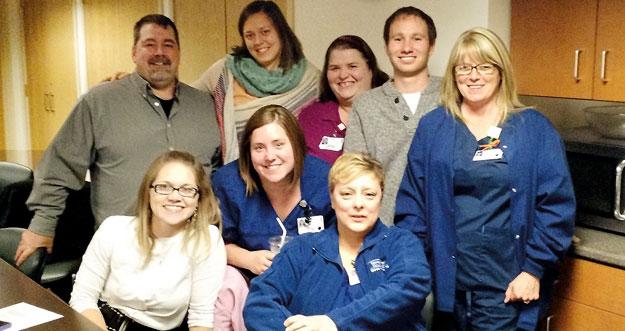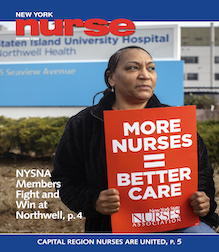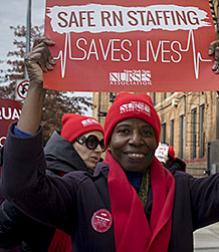
All over New York State, NYSNA nurses are pressing hard on safe staffing issues. While the campaign for passage of the Safe Staffing for Quality Care Act in the legislature is stepped up, nurses are taking actions in their hospitals to address patient safety concerns, and they’re achieving success.
NYC: Harlem Hospital
Harlem Hospital, one of the 11 public hospitals in the HHC system, is a recent example. “In many units, nurses are burdened with too many patients, especially during breaks and while nurses are on vacation or if a scheduled nurse calls in sick,” said Jacqui Gilbert, RN and a nurse supervisor at the hospital.
Mbayo Umba, an RN who works the night shift in the ICU, said staffing in his unit during the day shift was acceptable, but not at night. “There were nights in the ICU when we’d have 5 patients and 2 nurses. It was made worse by the fact that there tend to be higher admissions and testing at night.”
The nurses began a focused action. “We needed a plan,” said Mr. Umba. “We started a Protest of Assignment campaign throughout the hospital.” He talked with fellow nurses one by one, stressing that “the only way to make this right is to protect yourself by filing POAs.” He and others sent regular reminders and members started to get with the POA program. “We made a concerted effort to hold Assistant Directors of Nursing accountable on the POAs,” he said. “Every morning before I leave, I follow up personally with the ADN to make sure the POAs are signed.”
Hard evidence
“Last spring, we worked with NYSNA’s Education Department to compile the data from our POAs and put together a presentation for a labor management meeting,” said Jacqui Gilbert. “It was fact-based evidence that management couldn’t dispute. And we told them we would send the data to the State Health Department if staffing didn’t improve.” She added, “Initially, we thought management was inclined to address the problem, but then they flip-flopped.”
The nurses regrouped and formed a coalition together with AFSCME and the Doctors Council/SEIU, HHC’s other unions, for political outreach. The unions arranged for a September meeting and invited the area’s elected representatives — from City Council to Congress. All invited politicians were either there in person or sent a staff member. “We had a huge member turnout,” Ms. Gilbert said.
Nurses, doctors and support staff spoke out at the meeting. Ms. Gilbert summed up the nurses’ message: “Staffing directly impacts our ability to care for our patients appropriately, and administrators at HHC are not providing the resources we need to care for our patients properly. Evidence-based research demonstrates that lives are saved when there is adequate staffing.”
On September 25, Manhattan Borough President Gale Brewer sent a letter to HHC’s CEO Ram Raju setting out her concerns about staffing at Harlem Hospital: “The nursing staff in particular is very lean and must out of necessity be crisis-oriented rather than be able to provide the steady, close care patients require. . . . Passage of the Safe Staffing for Quality Care Act would help, but as an interim step your actions as CEO could begin to close this gap.”
Members have kept up the political outreach. On November 18, they met with NYS Assemblyman Keith L. T. Wright and NYC Councilmember Inez Dickens. They’ve continued their POA campaign, too, and last month started using NYSNA’s new text-based “Safe Staffing Captain” system for fast and easy reporting of unsafe ratios.
Mr. Umba is optimistic about the impact of these efforts. “In the ICU we’ve seen some improvement. The hospital floats nurses into the night ICU now. It’s not 100% yet, but we’re working to get there.”
NYC: New York Presbyterian
The hospital’s 24-bed Medical ICU takes care of its sickest patients, including any ECMO patients requiring one-on-one care. Census is often at near 100%. The nurses had experienced a slow, steady deterioration in staffing since the beginning of the year due to a combination of open positions going unfilled, high patient acuity, and an unusually high number of regular staff on medical leave.
Said one long-time NYSNA member, “Depending on both census and acuity, the MICU requires at least 14, and often 16 or 17, nurses. It got to the point that it was not uncommon for us to be 3 or 4 nurses short. Some days, we only had 11 or 12 nurses, and we would get no relief from the hospital’s ICU Float Pool, stretched to capacity filling the vacancies in the hospital’s 7 adult ICUs. It was becoming nearly impossible to do our assignments in a safe manner.”
In July, the nurses outlined their sentiments in writing and requested a meeting with administrators where they laid out the issues together with some of the hard data.
Around the same time, a new manager came on board who displayed a better understanding of the seriousness of the situation. “This, combined with the Medical Director’s receptiveness to our message, brought about big changes. They realized they had to shift gears for the sake of patient safety and retention of nursing staff,” said a NYSNA member.
By late August, travel nurses were assigned to the unit and management made a commitment to greater recruitment efforts. Since then, the hospital has increased the number of RNs in the Critical Care Float Pool, as well. The member reports that MICU nurses are pleased with the outcome so far. “Hiring takes time, but we have a process in place now that should yield a more permanent solution. We have a commitment from the administration to staff with an optimum number of FTEs plus 1 to make up for anyone on medical leave. So far, it’s working. Yesterday, we had a full complement of 17 RNs.”
She added, “I don’t believe the hospital was intentionally short-staffing the ICU. But without the input from nurses, they wouldn’t have realized the extent of the problems it was creating. It shows the importance of speaking up and letting them know what’s happening.”
North Country: Champlain Valley Physicians Hospital
When management at the 300-bed Plattsburgh facility that is part of the University of Vermont Health Network tried to eliminate charge nurses from the three Med/Surg floors, NYSNA nurses mobilized a fight back. “The hospital was pursuing magnet status and there was a lot of talk of ‘shared governance,’” said Dea Lacey, RN, who works there. “They used that rationale to try to eliminate charge nurses, saying that one nurse shouldn’t be in charge of another’s practice.”
After a one-week trial, the feedback from all the RNs was that it simply did not work. However, that wasn’t the end of it. “Management dug in their heels and pushed forward, despite our objections,” reported Ms. Lacey. On July 1, the first of the 4.5 charge nurse FTEs was eliminated; the other cuts were scheduled for August 1.
CVPH members got to work. In early July, they held unit meetings to mobilize and prepare for an escalation campaign. “We wrote a petition and 90 percent of the nurses signed it — not just in Med/Surg but from the whole hospital,” said Ms. Lacey. A group of ten RNs walked the petition into the CNO’s office. When the nurses received a dismissive response from the CNO, they turned it into a leaflet for distribution within the hospital.
The nurses then wrote a response to the CNO, which they shared inside the hospital as a leaflet. They started leafleting outside the hospital, as well, to let the community know about the issue and its impact on patient safety. Nurses from other floors and units were among the first to volunteer support. Ms. Lacey said, “When the Med/Surg nurses saw the level of support we were getting from nurses in other areas of the hospital, it made us stronger.” The nurses also used a July ruling by the Department of Labor that CVPH had violated overtime laws to its advantage, adding this issue to the nurses’ campaign.
By the end of July, there appeared to be some movement. The CNO resigned two weeks after delivery of the petition and management announced it would delay until fall the cuts on the other two floors that had been scheduled for August 1. The hospital’s VP for human resources took over as CNO and requested a meeting with the nurses.
The nurses agreed to meet only if the charge nurse issue would be addressed. However, once the meeting took place, management ignored the staffing issue. The 25 nurses in attendance all got up and left.
Yet again, at a second meeting, packed with NYSNA nurses, the staffing issue was ignored and nurses left en masse. Management went on to announce the elimination of the charge nurses on the other two Med/Surg floors.
Members immediately started organizing a candlelight vigil as well as a call-blast to the CNO.
Turning point
Once word of the impending vigil got out, coupled with an inundation of calls to the CNO, management finally agreed to negotiate. “I think the turning point was when we took control of that second meeting and all got up and walked out together,” Ms. Lacey said. “The Med/Surg RNs got together and wrote a very specific job description for charge nurse, listing qualifications and responsibilities. When management finally agreed to negotiate, we knew exactly what we wanted.”
It was a win for the nurses. Two negotiating sessions later, not only had the nurses achieved restoration of all 4.5 charge nurse FTEs, they had succeeded in changing the title to a “bid” (i.e., permanent) position. The nurses agreed to change the charge nurse position name to “team leader” but the differential remained the same. “All three Med/Surg floors and all three shifts will now have a charge nurse called team leader. The job description is the one we wrote and it is to be posted by December 1,” said a very pleased Dea Lacey.




